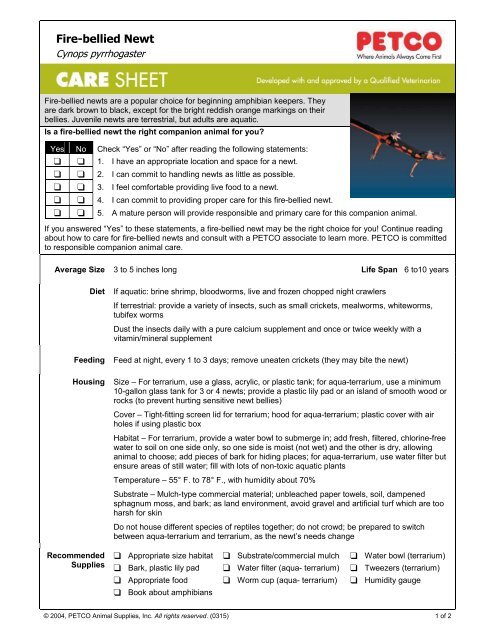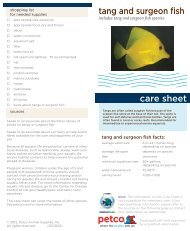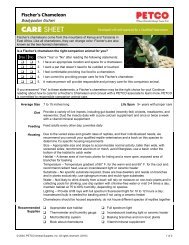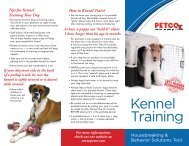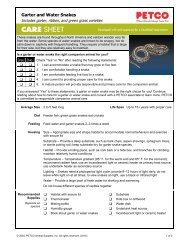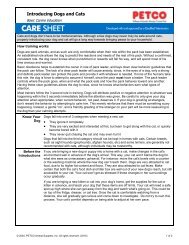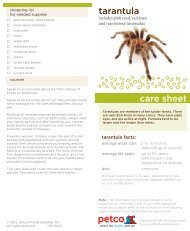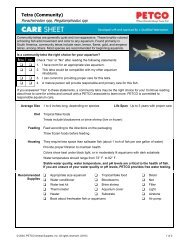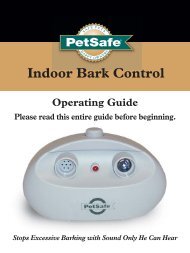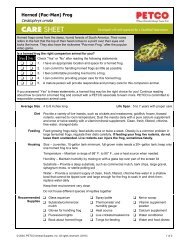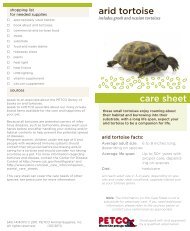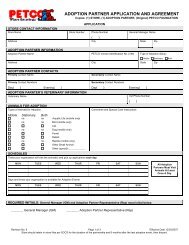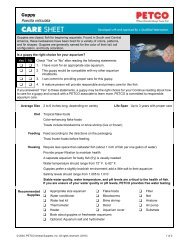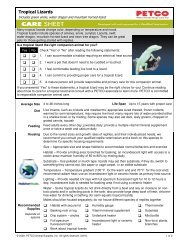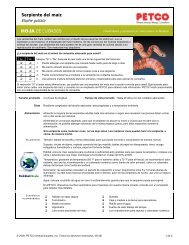Fire-bellied Newt - Petco
Fire-bellied Newt - Petco
Fire-bellied Newt - Petco
You also want an ePaper? Increase the reach of your titles
YUMPU automatically turns print PDFs into web optimized ePapers that Google loves.
<strong>Fire</strong>-<strong>bellied</strong> <strong>Newt</strong><br />
Cynops pyrrhogaster<br />
<strong>Fire</strong>-<strong>bellied</strong> newts are a popular choice for beginning amphibian keepers. They<br />
are dark brown to black, except for the bright reddish orange markings on their<br />
bellies. Juvenile newts are terrestrial, but adults are aquatic.<br />
Is a fire-<strong>bellied</strong> newt the right companion animal for you<br />
Yes No Check “Yes” or “No” after reading the following statements:<br />
❑ ❑ 1. I have an appropriate location and space for a newt.<br />
❑ ❑ 2. I can commit to handling newts as little as possible.<br />
❑ ❑ 3. I feel comfortable providing live food to a newt.<br />
❑ ❑ 4. I can commit to providing proper care for this fire-<strong>bellied</strong> newt.<br />
❑ ❑ 5. A mature person will provide responsible and primary care for this companion animal.<br />
If you answered “Yes” to these statements, a fire-<strong>bellied</strong> newt may be the right choice for you! Continue reading<br />
about how to care for fire-<strong>bellied</strong> newts and consult with a PETCO associate to learn more. PETCO is committed<br />
to responsible companion animal care.<br />
Average Size 3 to 5 inches long Life Span 6 to10 years<br />
Diet<br />
If aquatic: brine shrimp, bloodworms, live and frozen chopped night crawlers<br />
If terrestrial: provide a variety of insects, such as small crickets, mealworms, whiteworms,<br />
tubifex worms<br />
Dust the insects daily with a pure calcium supplement and once or twice weekly with a<br />
vitamin/mineral supplement<br />
Feeding<br />
Housing<br />
Feed at night, every 1 to 3 days; remove uneaten crickets (they may bite the newt)<br />
Size – For terrarium, use a glass, acrylic, or plastic tank; for aqua-terrarium, use a minimum<br />
10-gallon glass tank for 3 or 4 newts; provide a plastic lily pad or an island of smooth wood or<br />
rocks (to prevent hurting sensitive newt bellies)<br />
Cover – Tight-fitting screen lid for terrarium; hood for aqua-terrarium; plastic cover with air<br />
holes if using plastic box<br />
Habitat – For terrarium, provide a water bowl to submerge in; add fresh, filtered, chlorine-free<br />
water to soil on one side only, so one side is moist (not wet) and the other is dry, allowing<br />
animal to choose; add pieces of bark for hiding places; for aqua-terrarium, use water filter but<br />
ensure areas of still water; fill with lots of non-toxic aquatic plants<br />
Temperature – 55° F. to 78° F., with humidity about 70%<br />
Substrate – Mulch-type commercial material; unbleached paper towels, soil, dampened<br />
sphagnum moss, and bark; as land environment, avoid gravel and artificial turf which are too<br />
harsh for skin<br />
Do not house different species of reptiles together; do not crowd; be prepared to switch<br />
between aqua-terrarium and terrarium, as the newt’s needs change<br />
Recommended<br />
Supplies<br />
❑ Appropriate size habitat ❑ Substrate/commercial mulch ❑ Water bowl (terrarium)<br />
❑ Bark, plastic lily pad ❑ Water filter (aqua- terrarium) ❑ Tweezers (terrarium)<br />
❑ Appropriate food ❑ Worm cup (aqua- terrarium) ❑ Humidity gauge<br />
❑ Book about amphibians<br />
© 2004, PETCO Animal Supplies, Inc. All rights reserved. (0315) 1 of 2
<strong>Fire</strong>-<strong>bellied</strong> <strong>Newt</strong><br />
Cynops pyrrhogaster<br />
Normal<br />
Behavior and<br />
Interaction<br />
Habitat<br />
Maintenance<br />
Adults are mostly aquatic, but occasionally climb onto land to rest or bask<br />
Young newts have feathery gills behind their heads and look like tadpoles<br />
They breathe oxygen from the air and hold their breath when they dive<br />
Use an appropriate sized, small-mesh, soft net to move or block the newt while doing habitat<br />
maintenance; avoid handling; if you handle them be sure to wear latex gloves; residue or oil<br />
on your skin can harm amphibians<br />
In aqua-terrarium, use filter to help keep water clean; change water weekly<br />
Thoroughly clean the tank at least once a week: set newt aside in a secure habitat; scrub the<br />
tank and furnishings with a 3% bleach solution; rinse thoroughly with water, removing all smell<br />
of bleach; dry the tank and furnishings; and add clean substrate<br />
Grooming<br />
and Hygiene<br />
Signs of a<br />
Healthy Animal<br />
Common<br />
Health Issues<br />
Red Flags<br />
Inspect skin for abrasions, as well as signs of parasites, infection, or disease<br />
Always wear latex gloves if you must handle your newt and wash your hands after handling<br />
the habitat contents to help prevent Salmonella and other infectious diseases<br />
Eats regularly; digests food properly Maintains weight; avoids obesity<br />
Healthy skin; clear eyes<br />
Health Issue (alpha) Symptoms or Causes Suggested Action<br />
Gas Bubble Disease<br />
Metabolic Bone<br />
Disease<br />
Skin Problems<br />
Wounds<br />
Bloating; bubbles under skin<br />
surface; loss of balance.<br />
Deformities, soft bones,<br />
paralysis.<br />
Abrasions, bacterial and<br />
fungal infections.<br />
Most likely to happen when<br />
animal is introduced to new<br />
surroundings and panics.<br />
Ensure water is not too aerated;<br />
consult your veterinarian.<br />
Use vitamin/calcium supplements;<br />
consult your veterinarian.<br />
Consult your veterinarian.<br />
Consult your veterinarian.<br />
Weight loss Skin parasites Diarrhea<br />
Distressed breathing Lethargy Cloudy or dull eyes<br />
Skin lesions Bloated abdomen Poor balance<br />
If you notice any of these signs, please contact your exotic animal veterinarian.<br />
Sources<br />
Keeping Amphibians: A Practical Guide to Caring for Frogs, Toads, <strong>Newt</strong>s, and Salamanders<br />
(Unusual Pets Series) by Andrew R. Gray<br />
Salamanders and <strong>Newt</strong>s as a New Pet by John Coborn<br />
The World of Frogs, Toads, Salamanders, and <strong>Newt</strong>s by Robert Hofrichter<br />
Note: The information on this Care Sheet is not a substitute for veterinary care. If you need additional<br />
information, please refer to the above sources or contact your veterinarian as appropriate.<br />
2 of 2 SKU 942367 © 2004, PETCO Animal Supplies, Inc. All rights reserved. (0315)


